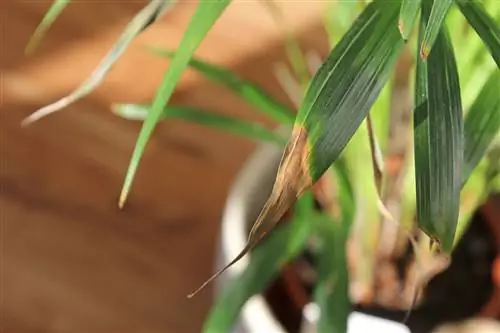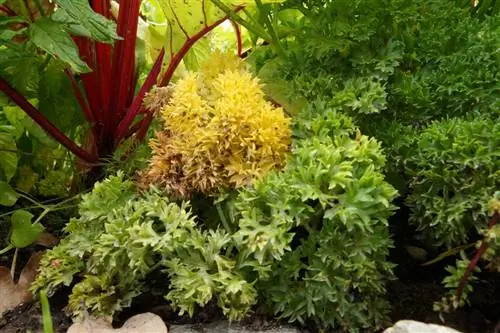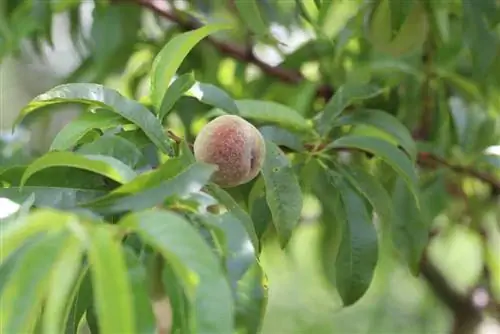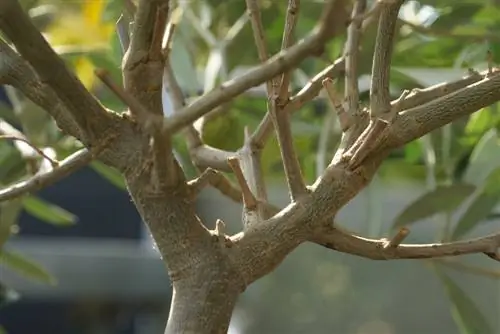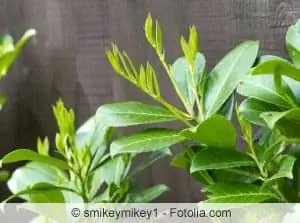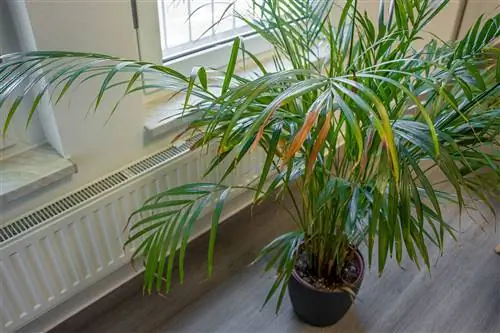- Author admin [email protected].
- Public 2023-12-17 03:39.
- Last modified 2025-01-24 12:45.
The causes of yellow and brown leaves and tips on palm trees are varied. One cause of brown and yellow leaves can be that the palm tree has been watered too often or too much. If you use a planter for a palm tree, you should also make sure that no water accumulates in the planter.
Causes of brown and yellow leaves and tips
Otherwise this would also lead to the soil and therefore the roots of the palm being too moist and the leaves and tips becoming a brown or yellow color, drying and eventually falling off.
Nutrient Deficiency
First yellow and later brown leaves on palm trees can also be a sign of nutrient deficiency. Palm trees are often in very small pots. The nutrients from it are usually used up quickly. You then plant them in a slightly larger pot and use fresh planting substrate. It is important to have a drainage layer at the bottom of the vessel so that the water can drain away unhindered. You can use this opportunity to remove old, dead or broken roots.
The nutrients from the fresh soil are used up after six to eight weeks. Then you can fertilize. Appropriate fertilizers for palm trees are available commercially. When dosed precisely, they give the plants strength to thrive. Be careful, an oversupply of nutrients can also lead to brown leaves, especially on date palms.
Another reason why the leaves and tips of a palm tree can turn brown or yellow is a lack of nutrients. Yellow and brown leaves can also appear on the palm tree in winter. This is due to the cold combined with too much watering. Another factor that can promote brown and yellow leaves and leaf tips on the palm tree is humidity. If this is too low, the leaves will dry out and fall off. Another possible cause of brown and yellow leaves is a lack of light.
Watering correctly
To avoid overwatering the palm tree, you should check the condition of the soil in which the palm tree is planted before watering. If the surface of the earth is dry, you can water the palm tree. If the soil is moist, you should definitely not water the palm tree, otherwise it can develop brown and yellow leaves and leaf tips because water will then accumulate on the palm tree's roots. This then also promotes a rotting process, so that the palm tree can die.
It is usually watered too much. Because they are afraid that the plants will dry out, they are watered too much. The root ball is in water and very few plants and palm trees, which usually get by with very little water, cannot tolerate this at all. Palm trees are more likely to tolerate being forgotten to water them. Very few of these are received. They drown much more often. Standing water in planters is particularly dangerous.
You can avoid this if you check about 10 minutes after watering that there is no water in the pot or saucer. If this is the case, it must be poured off. When caring for plants, it is important to water only moderately, regularly, but not too much. Planters with a water reservoir are favorable. The palm trees can help themselves from this if necessary, which is practical.
Repotting for a good supply of nutrients
If the plant pot in which the palm tree was planted is too small, the soil will not provide sufficient nutrients. That's why you should definitely repot the palm tree into a sufficiently large plant pot after buying it. When repotting palm trees that you already have, you should make sure to repot this palm in the spring. When repotting, it is also essential to create a drainage layer in the bottom of the plant pot so that water does not accumulate on the roots of the palm tree. As already described above, these water congestion would cause the roots to rot and yellow and brown leaves to appear on the palm.
When repotting the palm tree, the root system should be checked and damaged roots removed. After repotting, you should only water the palm tree enough so that the soil is slightly moist. Then you should wait until the soil on the surface has completely dried before watering again.
Wintering
Palms get a particularly large number of brown leaves if they are overwintered incorrectly. They are often too dark or too cold. They are usually watered too much. The individual species have different requirements when overwintering. Once you know which palm it is, you should be well informed about which conditions are preferred. The right location and appropriately dosed irrigation water will ensure that a palm tree survives the winter unscathed.
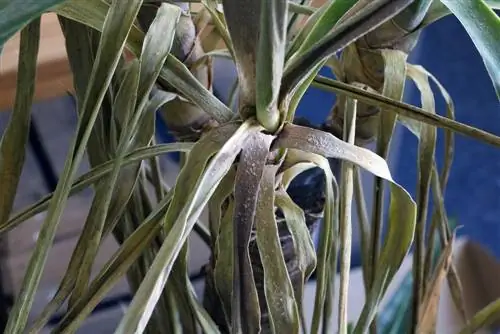
Winter can promote yellow and brown leaves and tips on palm trees due to cold, long days with little light and low humidity. If the humidity is too low, you should spray the leaves with water or wipe the leaves with a damp cloth. If the palm tree is in a cold place, you should only water the palm tree once or at most twice a month. When watering, you should also make sure that the soil on the surface is completely dry. To provide the palm tree with sufficient light, you can use a plant lamp, which provides the palm tree with several hours of light every day.
Too low humidity
Palm trees generally love high humidity. If the humidity is too low, not only brown leaves appear, but also pests such as spider mites. The safest method for the plants is to spray them with water regularly. It is best to use rainwater, especially if you have very hard water. Limescale spots on the palm fronds don't look nice and many plants don't tolerate hard water well. A water sprayer works well.
Too dark location
Palm trees love light in most cases. They need a lot of light. In winter the lighting conditions are rather poor, especially if the palm trees are not directly at the window. Because of their size, they often don't fit on the window frame and have to move to a place further inside the room. But it's usually too dark there for them. You can remedy this with a special plant lamp. Other plants also enjoy this additional light, especially in winter.

